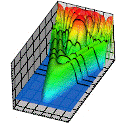Department of Physics and Astronomy: Publications and Other Research

Anthony F. Starace Publications
Document Type
Article
Date of this Version
April 1982
Abstract
An overview of the theory of photoelectron angular distributions for atoms is presented. Its features, which are embodied in a single asymmetry parameter β in the electric dipole approximation, are examined within the framework of the angular momentum transfer formulation. The β parameter is in principle always energy dependent. Within the LS coupling approximation, however, there are instances, each representing a multitude of particular photoionization processes, in which β is an analytically determined constant. The energy dependence of the β parameters in such instances is due entirely to spin-orbit and other relativistic interactions. The study of the energy dependence of the β parameter in these cases is thus of interest because it spotlights weak-interaction effects which are usually overwhelmed by stronger interactions. We illustrate the general predictions by a detailed consideration of the energy dependence of the β parameter for s-subshell photoionization processes. It is shown that the asymmetry parameters for atomic s subshells are particularly suitable for distinguishing between purely geometrical effects on the photoelectron angular distribution, resulting from physical conservation laws, and dynamical effects arising from relativistic interactions and electron exchange and correlation. In general, the β parameters for s subshells vary with energy; such variation is largest near minima in the cross sections for the corresponding photoelectron channels and in the vicinity of resonances. However, a number of atomic photoionization transitions are identified for which β would be a constant (equal to one of the three values 2, 1/5, or - 1) were it not for relativistic interactions and (in some cases) final-state interchannel coupling and/or initial-state electron correlations. Measurement or calculation of the β parameters for such transitions thus provides a sensitive measure of the strength of relativistic interactions as well as of electron correlations.


Comments
Published in Review of Modern Physics 54:2 (April 1982), pp. 389-405. Copyright © 1982 The American Physical Society. Used by permission. http://link.aps.org/abstract/RMP/v54/p389